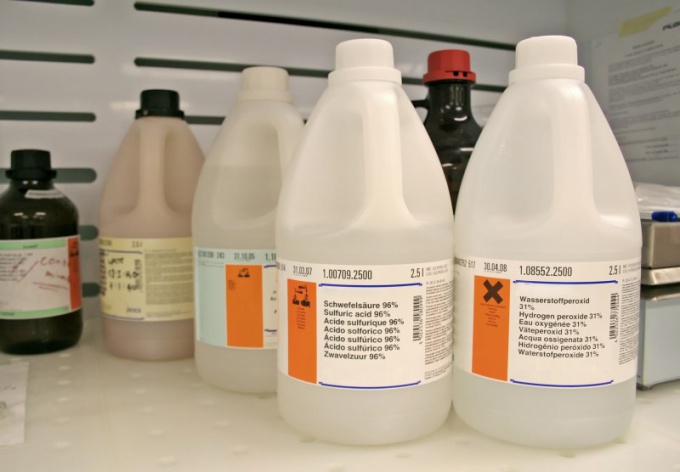Instruction
1
H2O2 molecules in the liquid state are strongly associated, due to the presence between them of hydrogen bonds. Since hydrogen peroxide can form more hydrogen bonds than water (for every atom of hydrogen has more atoms of oxygen), its density, viscosity and boiling point, respectively, above. It mixes with water in all respects, and pure peroxide and concentrated the solution in the light explode.
2
At room temperature, H2O2 catalytically decomposes to release atomic oxygen, hence its use in medicine as a disinfectant means. Usually take the 3% antiseptic solution.
3
In the industry hydrogen peroxide is obtained in the reactions with organic compounds, including, for example, catalytic oxidation of isopropyl alcohol:
(CH3)2CHOH+O2=(CH3)2CO+H2O2.
Acetone (CH3)2CO is a valuable byproduct of such a reaction.
(CH3)2CHOH+O2=(CH3)2CO+H2O2.
Acetone (CH3)2CO is a valuable byproduct of such a reaction.
4
Also H2O2 is produced industrially by electrolysis of sulfuric acid. In this process, the persulfuric acid is formed, the subsequent decomposition of which gives the peroxide and sulfuric acid.
5
In the laboratory peroxide get usually the action of dilute sulphuric acid on barium peroxide:
BaO2+H2SO4(highest.)=BaSO4↓+H2O2.
Insoluble barium sulfate precipitates.
BaO2+H2SO4(highest.)=BaSO4↓+H2O2.
Insoluble barium sulfate precipitates.
6
The peroxide solution has an acid reaction medium. This is because of the H2O2 molecules dissociate on the type of the weak acid:
H2O2↔H(+)+(HO2)(-).
The dissociation constant of H2O2 – 1,5∙10^(-12).
H2O2↔H(+)+(HO2)(-).
The dissociation constant of H2O2 – 1,5∙10^(-12).
7
Showing the properties of acids, hydrogen peroxide interacts with bases:
H2O2+Ba(OH)2=BaO2+2H2O.
H2O2+Ba(OH)2=BaO2+2H2O.
8
The peroxides of certain metals, such as BaO2, Na2O2, can be considered as salts of hydrogen peroxide is a weak acid. Of them just get in the laboratory H2O2 by the action of stronger acids (e.g., sulfuric), displacing the peroxide.
9
Hydrogen peroxide can react in three types: without a change in the peroxide group, as a reductant or as an oxidant. The last type of the most characteristic reactions for H2O2. Examples:
Ba(OH)2+H2O2=BaO2+2H2O
2KMnO4+5H2O2+3H2SO4=2MnSO4+K2SO4+5O2+8H2O,
PbS+4H2O2=PbSO4+4H2O.
Ba(OH)2+H2O2=BaO2+2H2O
2KMnO4+5H2O2+3H2SO4=2MnSO4+K2SO4+5O2+8H2O,
PbS+4H2O2=PbSO4+4H2O.
10
The hydrogen peroxide finds wide application. It is obtained from the bleach entered into synthetic detergents, various organic peroxides; it is used in the polymerization reactions for the restoration of paintings on the basis of lead paints and to obtain antiseptic.
